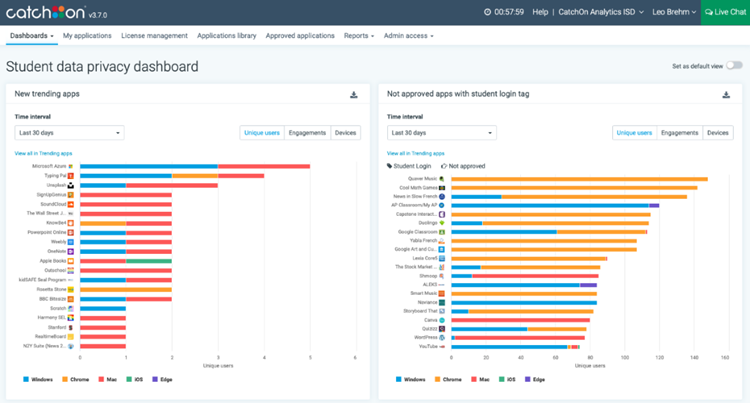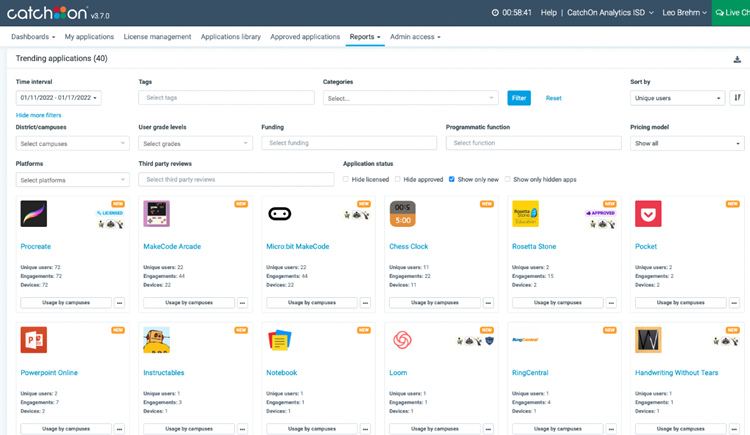CatchOn is a learning analytics platform that allows districts to evaluate the ROI of their EdTech investments, track student engagement in meaningful ways that contribute to actual growth, and ensure that all the technology in use in a district is compliant with national and state data-privacy laws and regulations.
In 2020, CatchOn partnered with Digital Promise to pilot the platform in seven districts that are part of the League of Innovative Schools. The subsequent report includes case studies for all seven districts that delve into how they are using CatchOn to turn data into action. According to the report, 100% of the leaders from the Digital Promise pilot school districts found that:
- CatchOn data is valuable for informing their ROI analysis on technology investments; and
- Reviewing their CatchOn data helps them identify gaps in student engagement that can indicate inequity;
- CatchOn data is valuable for supporting their district’s online learning initiatives.
Formats/platforms used:
CatchOn has agents that collect data from a range of platforms, including:
- Windows;
- Mac;
- iOS;
- Chrome browser extension; and
- an Edge browser extension.
Each device only needs one agent, but CatchOn is able to adapt to mixed environments—for example, when teachers have Windows devices and students have Chromebooks—and still collect all the data.

Only the Chrome browser extension and Edge extension give insight into active windows. All others count engagements only.
Primary URL:
Problem solved:
CatchOn helps administrators gauge the efficacy of edtech deployments, student engagement with technology, the strength of student data privacy tools and initiatives, and return on investment in technology.
Grade/age range:
CatchOn is appropriate for use districtwide.
Subject/topic/standards:
CatchOn’s third-party badging certifications from well-respected organizations such as IMS Global Learning Consortium and the Student Data Privacy Consortium enable users to quickly determine if each app’s privacy policies match security guidelines issued by FERPA, COPPA, and GDPR.
Lesson time needed:
CatchOn is an administrative tool and does not require class time.
Pricing model:
CatchOn is intended as a districtwide platform; pricing is based on the size of the district.

Additional services needed:
Any customer devices must be managed by a mobile device management tool and gathering roster data requires a student information system, but districts do not need anything else to use CatchOn because it is designed to extract data from the systems, platforms, and apps already in use.
What makes CatchOn unique?
CatchOn’s customizable dashboard lets users see, share, and analyze their data—by district, school, class, or student—to meet their specific objectives. CatchOn allows administrators to view both active and passive student activity to better understand student engagement.
Here's what users are saying:
“We want to move away from the practice of continuing to buy certain programs or tools because they have a strong legacy in education. Instead, we are going to be asking more critical questions around our renewals and licensing, such as, ‘What’s the adoption like? What’s the effectiveness of the product? Is it helping our students and teachers achieve their goals?’ And those are tough questions to answer if you only have subjective and circumstantial information. CatchOn provides us objective data we can use to inform and answer these questions.”
—Jeff Faust, chief technology innovation officer at Chesapeake Public Schools
“For the first time, I could actually see our one-to-one working the way it is designed to work. Instead of the devices solely being used for assessments and testing, students and staff were using their edtech tools and devices for educational and curriculum purposes. We had 27,000 kids online, and I was able to see how active and engaged they were through CatchOn.”
—Homer Coffman, chief technology officer at Baldwin County Public Schools
“From a curricular lens, we are making decisions based on need and support both for teachers and students. For us, it’s not just a monetary investment in the platform itself. With Gizmos, for example, we hosted and paid for several professional development sessions. Looking at the usage data reaffirms that we are making effective decisions, and it shows me how valuable our teachers find that particular program for online science, investigation, and inquiry.”
—Brian Young, director of curriculum and instruction for Morris School District










